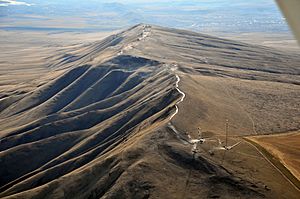Arid Lands Ecology Reserve facts for kids
The Arid Land Ecology Reserve is a very special place in the U.S. state of Washington. It's the largest area of its kind, called a shrub-steppe ecosystem, left in the entire United States. Think of a shrub-steppe as a dry grassland with lots of shrubs mixed in. This reserve helps protect unique plants and animals that live in this type of environment.
Contents
What is the Arid Land Ecology Reserve?
The Arid Land Ecology Reserve is a large natural area. It covers about 320 square kilometers (which is about 124 square miles). This reserve is part of an even bigger area called the National Environmental Research Park, which is about 1500 square kilometers (579 square miles).
Where is it Located?
This important reserve is found near Richland, Washington, on the northwest edge of the Hanford Site. The Hanford Site is a large area that was once used for government projects, but now parts of it, like the reserve, are set aside for nature.
Who Manages This Special Place?
The Arid Land Ecology Reserve is looked after by the Pacific Northwest National Laboratory. This laboratory works for the United States Department of Energy, a part of the U.S. government. They make sure the reserve is protected and studied, helping us learn more about dry land ecosystems.
The Big Fire of 2000
On June 27, 2000, a large wildfire swept through the Arid Land Ecology Reserve. This fire caused a lot of damage. It burned away most of the native plants that had lived there for a long time. These native plants included sagebrush and a type of grass called bunchgrass.
How the Fire Changed the Plants
After the 2000 fire, the landscape of the reserve changed a lot. Even though people tried to bring back the native plants, many new plants that are not from this area started to grow. These non-native plants include cheatgrass, knapweeds, and Russian thistle, which is also known as tumbleweed. These plants grew very well after the fire.
Some of the original plants, like spiny hop sage and Wyoming big sagebrush, were almost completely destroyed by the fire and its effects. This shows how much a single event like a fire can change an entire ecosystem.


